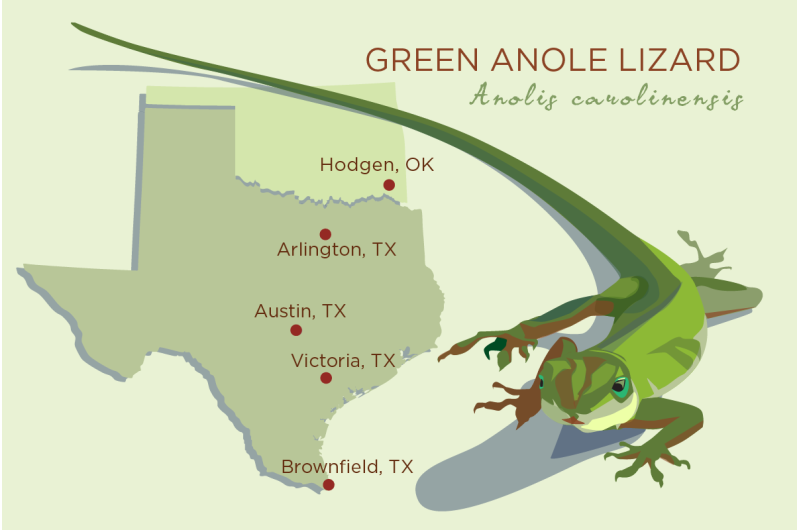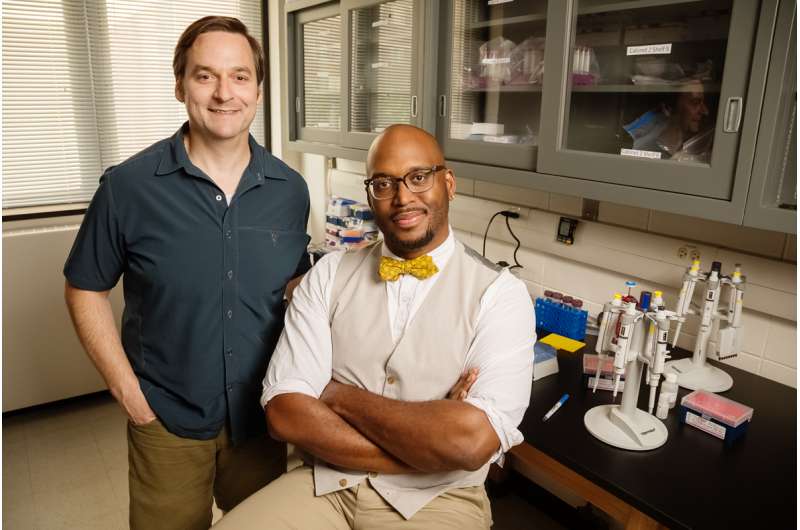Lizard blizzard survivors tell story of natural selection

An unusually cold winter in the U.S. in 2014 took a toll on the green anole lizard, a tree-dwelling creature common to the southeastern United States. A new study offers a rare view of natural selection in this species, showing how the lizard survivors at the southernmost part of their range in Texas came to be more like their cold-adapted counterparts further north.
The study is reported in the journal Science.
"We were able to track natural selection at the level of the whole organism, but also at the level of gene sequence and gene expression," said University of Illinois postdoctoral researcher Shane Campbell-Staton, who led the new research. "I think this is a really strong and clear story about biological responses to extreme weather events."
It's rare for a biologist to get such an intimate view of natural selection in animals in the wild.
"These extreme weather events, they're unpredictable by nature," Campbell-Staton said. "And unless you happen to have data beforehand, like I did, it's pretty much impossible to do this sort of study."
Just before that fateful winter, Campbell-Staton had studied five groups of anole lizards, ranging from the southern tip of Texas to Hogden, Oklahoma, nearly 800 miles to the north. He was trying to understand how these cold-blooded reptiles could survive so far north. Their range also extends into North Carolina, Mississippi and Tennessee.

"We don't consider that very far north, but this is a subtropical lizard," he said. "It's the only species of about 400 in this genus that gets this high in latitude."
In August 2013, Campbell-Staton collected DNA from several dozen anole lizards and also gathered data relating to their gene-expression profiles, information that can show which genes were being transcribed and translated into proteins and at what levels. He also tested the lizards' ability to physically function in the cold.
After his field work, he went home to his Harvard University laboratory, telling his adviser he had finished collecting data.
Then a record-breaking winter, stirred by a change in the polar vortex, altered weather patterns across the U.S.
When he saw a photograph of an anole lizard lying dead on its back in the snow, Campbell-Staton realized he ought to go back to study the lizards that survived the storm. He and colleagues from Harvard and the University of Texas went back the following spring and again in August to collect the same data on the same populations he had studied before.
When the researchers analyzed the data, they saw a consistent signature of natural selection in the lizard survivors from the southernmost sites.
"One of the great things about this study is that we had three independent lines of evidence - DNA markers, gene expression levels and physiology measures - all pointing to the same biological signal, a shift toward more robustness against cold weather," said University of Illinois animal biology professor Julian Catchen, a co-author of the study.
Many lizards survived, and the survivors were likely better able to tolerate future cold-weather events. But the story is not entirely rosy, the researchers said.
"One might think, 'Oh, they responded! They're better now.' But selection always comes at a cost, which is death, basically," Campbell-Staton said. "It may be that the animals that did not survive this storm had the genetic variants to survive a heat wave, or a drought or some other extreme event. And now those lineages are essentially gone."
Scientists are just beginning to understand how extreme weather events - which are expected to increase as global temperatures rise - affect natural populations, Campbell-Staton said.
"How will these different extreme weather events combine to affect aspects of selection and evolution in natural populations? That's a very important question moving forward," he said.
The National Science Foundation, Harvard University and the U. of I. supported this research. Campbell-Staton began this work as a graduate student in the laboratories of Jonathan Losos and Scott Edwards at Harvard.
More information: S.C. Campbell-Staton el al., "Winter storms drive rapid phenotypic, regulatory, and genomic shifts in the green anole lizard," Science (2017). science.sciencemag.org/cgi/doi … 1126/science.aam5512
Journal information: Science
Provided by University of Illinois at Urbana-Champaign




















